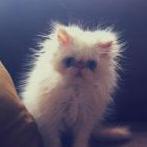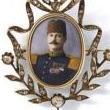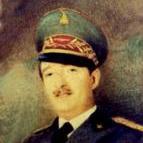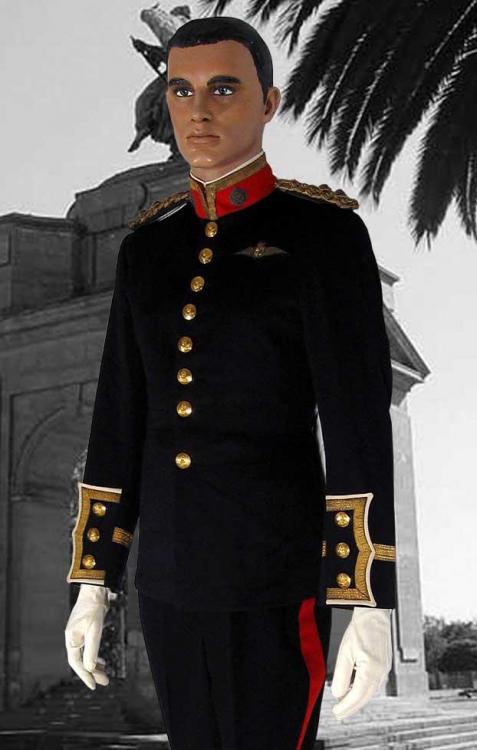-
Posts
197 -
Joined
-
Last visited
About rathbonemuseum

Contact Methods
-
Website URL
http://www.rathbonemuseum.com
-
ICQ
0
Profile Information
-
Gender
Male
-
Location
New York
-
Interests
Facebook
http://www.facebook.com/rathbonemuseum
Recent Profile Visitors
4,407 profile views
rathbonemuseum's Achievements
-
Excellent badge. Very rare and small conflict. Only a handful of aircraft contesting.
-
What a great thread and sorry I am so late to seeing it. I have never seen the summer full dress. Wow. Below are some of the uniform types referred to. All belonged to E. A. Pope. Went on to become staff officer, Lt Col, armament office for 3 group in WWII. Fortunately all his pre-war finery survived including his dress blues, undress blues and mess dress. (http://www.rathbonemuseum.com/SAAF/SAAFMain.html). Tod Also, since some of you have the uniform regulations, does it describe the sash worn with the full dress uniforms and the headgear? Was it the white pith helmet with the springbok?
-
I realize this is an old thread but thanks to everyone who commented. Some things that I feel are more correct about the uniform: - the name and ink seem original. The 1943 date, captain rank in ink and captain rank on shoulder seem to line up. Therefore no relationship to Roland Marillier the fighter pilot. - the uniform was tailored in SA. - the ribbon bar is a fanciful addition - The RAF/SAAF wing will not resolve until I actually can identify the man and a) if he even qualified for them or served in any air force; and b) if he did, what service did he qualify in and what unit(s) did he serve in. For now, I will keep trying to narrow down any South African Marillier that was a captain in 1943 and see where the chips fall. cheers, Tod
-
Danny63, That is an Imperial Japanese navy badge. It is for those naval personnel trained for amphibious landings and assaults and therefore is often referred to as the naval landing forces badge. I have not seen or read the original regulations so I am not sure what specific training or qualification was required to wear the badge. Please see https://en.wikipedia.org/wiki/Special_Naval_Landing_Forces Cheers, Tod
-
The Navy did not have the equivalent of these badges. They had blue colored piping on officer rank and blue colored sakuras on the petty officer ranks that signified they were part of the air branch of the Imperial Navy. There were metal proficiency badges (1st and 2nd class) that were awarded to air branch personnel for passing skill tests (similar in idea to graduation badges). There was no general badge worn to indicate flight qualified or flight trained like the army badges above. It sounds like you are referring to something specific though?
-
Clearly translated with no sense of what classifies a military aviator. Just a literal translation of words. There are all kinds of aviation classifications in all the WWII air forces. The key word is "qualification." If one is flight qualified or pilot qualified, then they are considered trained to actually fly the plane. None of these seem to be specific. The only flight badge seems to be the small 'air personnel' badge which at least seems to indicate one served a role in a flying military aircraft (as opposed to ground support, mechanic, anti-air, etc)
-

Unidentified Unknown IJN aviation pin badge
rathbonemuseum replied to rathbonemuseum's topic in Japan
Taiatan? I am wondering if this badge was awarded to 1) personnel who commited Taiatan attacks, or 2) next of kin, or 3) was a unit badge? I am wondering if the translation is related to these kinds of ramming attacks: (from Wikipedia) The Japanese also practiced ramming, both by individual initiative and by policy. Individual initiative was involved in the bringing down of a lone B-17 Flying Fortress The Flying Swede on 8 May 1942 by a Nakajima Ki-43 fighter plane. After three of the Japanese fighters had each made two attack passes without decisive results, the bomber's pilot, Major Robert N. Keatts, made for the shelter of a nearby rain squall. Loath to let the bomber escape, Sgt. Tadao Oda executed a head-on ramming attack, known as taiatari (体当たり tai-atari?, "body strike").[15] Both aircraft were destroyed with no survivors. Sergeant Oda was posthumously promoted to lieutenant for his sacrifice.[16] On 26 March 1943, Lieutenant Sanae Ishii of the 64th Sentai used the wing of his Nakajima Ki-43 to ram the tail of a Bristol Beaufighter, bringing it down over Shwebandaw, Burma. Squadron Leader Ivan G. Statham AFC and Pilot Officer Kenneth C. Briffett of 27 Squadron RAF were both killed. On 1 May 1943, Sergeant Miyoshi Watanabe of the 64th Sentai used his Nakajima Ki-43 to ram the rear turret of a B-24 Liberator after a drawn-out battle with the American bomber over Rangoon. Sergeant Watanabe survived the attack and made a forced landing. On 26 October 1943, Captain Tomio Kamiguchi of the 64th Sentai used his Nakajima Ki-43 to ram a B-24 Liberator when his guns failed to fire. Already heavily damaged by the other Japanese fighters in the 64th, the bomber (belonging to the 429nd Bomb Squadron) crashed near Rangoon. On 6 June 1944, having expended his ammunition in an extended dogfight, Sergeant Tomesaku Igarashi of the 50th Sentai used the propeller of his Nakajima Ki-43 to bring down a Lockheed P-38 Lightning near Meiktila, Burma. After the pilot bailed out, Igarashi attacked him in his parachute.[17] The P-38 may have belonged to 10-kill ace Captain Walter F. Duke of the 459th Fighter Squadron who was lost in battle that day.[18] Starting in August 1944, several Japanese pilots flying Kawasaki Ki-45 and other fighters engaging B-29 Superfortresses found that ramming the very heavy bomber was a practical tactic.[19] From that experience, in November 1944 a "Special Attack Unit" was formed using Kawasaki Ki-61s that had been stripped of most of their weapons and armor so as to quickly achieve high altitude. Three successful, surviving ramming pilots were the first recipients of the Bukosho, Japan's equivalent to the Victoria Cross or Medal of Honor, an award which had been inaugurated on 7 December 1944 as an Imperial Edict by Emperor Hirohito.[20][21] Membership in the Special Attack Unit was seen as a final assignment; the pilots were expected to perform ramming attacks until death or serious injury stopped their service. The Japanese practice of kamikaze may also be viewed as a form of ramming, although the primary mode of destruction was not physical impact force, but rather the explosives carried. Kamikaze was used exclusively against Allied ship targets. -
Thank you for all the official regulations from the Diet archives. I think I would sum up (my personal summation) what was written as follows: In 1943, the large wing with star was introduced to all IJA personnel who received flight training. You would have been trained in basic operations of aircraft, principals of flight, emergency procedures and would have flown a certain number of hours. That is why cadets and surgeons were involved. An analogy could be made to parachute training. Anyone who has gone through the training is considered jump qualified and can wear the jump badge. In this case, any Army personnel who went through flight training (vs. pilot training) was eligible to wear the badge. It is unclear at this point if the different style of badges had anything to do with rank or type of uniform to be worn on. The smaller badge then, the one shaped like an eagle, was established in 1944 to signify those Army personnel who were part of an active flight crew. This makes sense that these men would want to signify they were the ones actually flying in the planes vs. flight trained. Does this make sense? Anyone know any IJA veterans to ask?
-
Typically no, surgeons did not fly in planes. If they were associated with a flying unit and were trained in the effects of flying on human health, they would be the units flight surgeon. At least that it is how it was in the US. They were aviation related but not pilots or crew. I still am wondering if the larger wing specified that the wearer was flight qualified: i.e. a pilot. Someone who actually was trained to fly. or, if this was a branch of service device for anyone related to aviation in the army.
-
So it seems that a lot of personnel were entitled to wear the wings (航空胸章) I am not sure what they signified then. It seems the smaller eagle badge was for all active flight personnel. So were the larger wings for ALL members of the air branch or the IJA even if they did not fly in a plane?
-
period photos
-
Service dress tunic (vs. tropical above)








